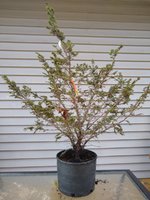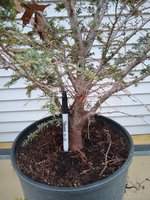I think this really is an eastern or Canadian hemlock,
Tsuga canadesis just not a really healthy one. I see no reason to doubt the nursery label. Natural styles for eastern hemlock usually have ascending branches, above horizontal. The drooping branches one sees in some spruce or fir is not how the eastern hemlock grows. Often I have seen them with candelabra form. They are a forest tree, you seldom see a lone hemlock in a field, so there are not a lot of photos of "lone hemlock, in a field". In the forest they are hard to get good photos of.
Other than form, I do agree with
@River's Edge , your best bet is to leave the foliage alone this immediate upcoming season. Work on repotting, and reducing depth of the root system. I like Anderson flats for initial training of trees. They are 16 x 16 x 5 inch deep, with mesh bottoms. THey hold roughly 3 gallons of potting media. I would work of repotting in spring and try to step this tree into a wide shallow training container, Anderson flat or a home made training box, of somewhat similar dimensions. If you are going to work the roots, don't remove any foliage for 4 months prior and no foliage removal for the growing season after major root work.
I look at the tree, and the first 2 branches are almost, but not quite "bar branches", and my initial impression would e to eventually remove the right or the left branch. But I think you will be better served keeping all the branches for 2021. Do your repot in spring of 2021, and allow it to recover. Full sun will really help this to pick up in health and vigor. Letting it grow for several years, as River's Edge suggested is your best bet. Get the root system flattened out.
Standard "off the shelf" bonsai pots are almost always less than 4 inches deep. If you need a deeper pot, generally you need to have them custom made, and this can be expensive. This is why an Anderson flat is so useful. It holds enough media for rapid growth and yet is only 5 inches deep. I normally only fill my Anderson flats to the 3 or 4 inch depth.



